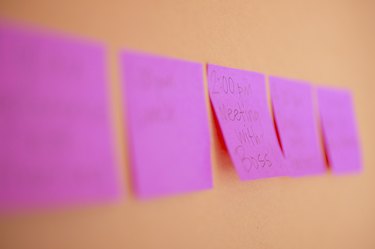
Sticky residues left by tape, grease or food may be found on a variety of surfaces in your home. If the spots are caught right away, most sticky residues easily are cleaned with a bit of soapy water. However, sticky spots left for a period of time can be challenging to remove. The best method to remove sticky residues depends on the material you're cleaning.
Electronics
Video of the Day
Step 1
Turn off and unplug all electronics before you begin to clean, to avoid electrical shock.
Video of the Day
Step 2
Remove surface grime and sticky residues from electronics casing using a wet wipe. Do not clean the electrical components or exposed wires with the wet wipe; only the cases that house these components.
Step 3
Wipe surface dust from LCD screens with a dry microfiber cloth. A paper towel or an old rag is too abrasive for screens.
Step 4
Dampen the cloth with water and add a few drops of 90-percent isopropyl alcohol. Wipe sticky residue from screens and other hard surfaces.
Step 5
Unplug keyboards, and DVD or CD players. Gently shake out debris.
Step 6
Dip a cotton swab into some alcohol and gently rub away sticky residue from the keys or controls. An alcohol-dampened swab also can be used to lift dirt from keyboard crevices and remote-control buttons.
Fabrics
Step 1
Scrape off excess residue from fabrics such as curtains, clothing and upholstery using your fingernail or a blunt edge such as a spoon.
Step 2
Rub waterless hand cleaner into the remaining residue on washable fabrics with your hands, then gently rub your hand over the residue to roll off the bits of adhesive.
Step 3
Apply a prewash stain remover to stubborn residue on fabrics and leave it for the time recommended on the label.
Step 4
Place the fabric item into the washing machine and launder as usual.
Step 5
Sponge residue on upholstery and carpeting with a cloth dampened with dry-cleaning solvent.
Step 6
Blot the residue with a dry cloth until the solvent is absorbed. Continue applying the solvent and blotting it dry until the residue is gone.
Step 7
Mix 1 tablespoon of liquid dish soap and 1 tablespoon of white vinegar into two cups warm water.
Step 8
Sponge the solution onto stubborn carpet residues. Blot with a dry cloth to absorb the solution and the sticky residue.
Step 9
Apply cold water to the treated area, then blot it dry. Reapply solvent to remove if any residue remains.
Walls, Trim, Doors and Cupboards
Step 1
Wipe the surface with soapy water to remove surface dust and debris. Rinse with clean water.
Step 2
Dampen a sponge with vinegar and scrub the sticky residue from the surface. Rinse with clean water to remove the vinegar.
Step 3
Remove stubborn residues by mixing equal parts baking soda and water to make a thick paste. Add more baking soda if necessary to make a paste thick enough that it won't drip down vertical surfaces such as cabinets and walls.
Step 4
Apply the paste to the sticky residue using a sponge or a clean cloth. Make sure the paste fully covers the residue.
Step 5
Leave the paste to dry, then scrub the area with a soft-bristled brush dampened with water.
Step 6
Rinse the surface with clean water to remove all traces of the paste. Reapply the paste to remove all traces of the sticky residue that remain.